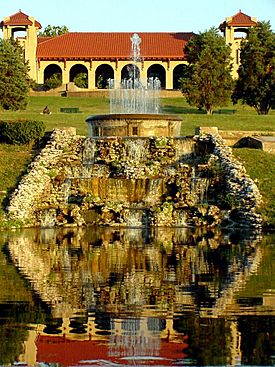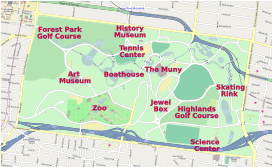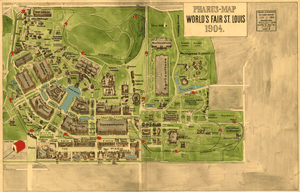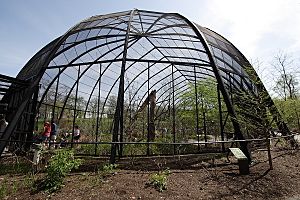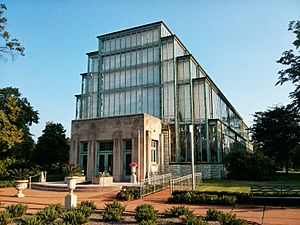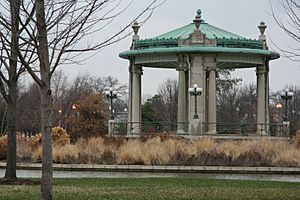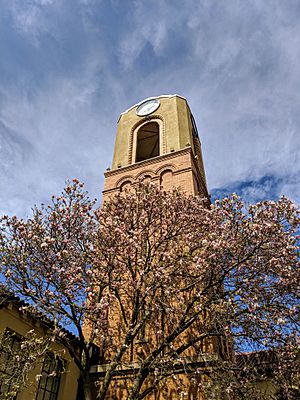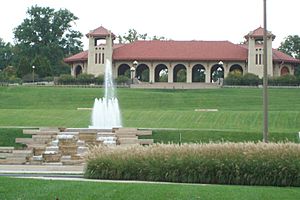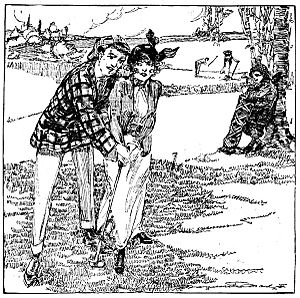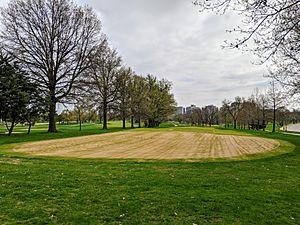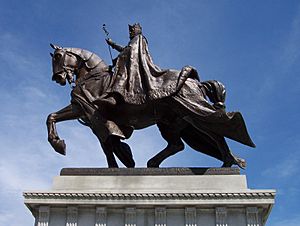Forest Park (St. Louis) facts for kids
Forest Park is a huge public park in St. Louis, Missouri. It's like the "Heart of St. Louis" because it's a very important place for the city. The park covers about 1,326 acres (5.37 km2), which is a lot of space!
It first opened in 1876. Since then, it has hosted many big events. These include the Louisiana Purchase Exposition (a World's Fair) in 1904 and the 1904 Summer Olympics.
Forest Park is surrounded by important places. These include Washington University in St. Louis and busy streets like Kingshighway Boulevard. Inside the park, you'll find amazing attractions. These are the Saint Louis Zoo, the Saint Louis Art Museum, the Missouri History Museum, and the Saint Louis Science Center.
Since the early 2000s, the park has been getting a big makeover. Over $100 million has been spent to make it even better. This includes improving the land and creating new natural areas. The park has meadows, trees, ponds, lakes, and streams. They've also been restoring prairie and wetlands. This helps reduce flooding and brings in many different birds and wildlife.
Contents
- History of Forest Park
- What You Can Do in Forest Park
- Amazing Features of Forest Park
- Saint Louis Zoo
- Saint Louis Science Center
- Missouri History Museum
- Saint Louis Art Museum
- The Muny
- The Jewel Box
- Turtle Park
- Dwight Davis Tennis Center
- Boathouse
- Pagoda Circle
- Dennis and Judith Jones Visitor and Education Center
- Steinberg Skating Rink
- The World's Fair Pavilion
- Forest Park Golf Course
- Highlands Golf and Tennis Center
- Lakes and Water Features
- Kennedy Forest and Kennedy Woods
- Cabanne House
- Statues and Memorials
- Images for kids
- Brickline Greenway
- See also
History of Forest Park
How the Park Started
People in St. Louis wanted a big park for a long time. In 1872, a developer named Hiram Leffingwell suggested a park. It would be about 1,000 acres (4.0 km2) outside the city. After some discussion, the city was allowed to buy the land.
But taxpayers went to court, and the plan was stopped. Then, in 1874, another developer, Andrew McKinley, made a new plan. This plan worked! The land chosen for Forest Park was a large, forested area. It was about 1,326 acres (5.37 km2) big.
Building the Park
In 1874, a law called the Forest Park Act was passed. This law created the park. It also set up a tax to pay for it. The city bought the land for about $850,000. Another million dollars was set aside for keeping the park nice.
When the park opened in 1876, it was very rural. There were dirt roads on its edges. The River des Peres flowed through the northern part. Sometimes it was low, and sometimes it flooded. The southwest part was heavily wooded.
Maximillian G. Kern and Julius Pitzman designed the park. It was officially opened on June 24, 1876. About 50,000 people came to the dedication. They dedicated a statue of Edward Bates, who worked for President Abraham Lincoln. By the 1890s, streetcars reached the park. This brought nearly 3 million visitors each year! Animals from an old zoo were also moved to the new Forest Park.
The 1904 World's Fair
In 1901, Forest Park was chosen for the 1904 World's Fair. It was called the Louisiana Purchase Exposition. The fair opened on April 30, 1904. It closed on December 1, 1904. This event changed the park a lot.
The park also hosted some events for the 1904 Summer Olympics. These included diving, swimming, and water polo. It was the first time African Americans were allowed to compete in the Olympics.
George Kessler, the fair's landscape designer, made big changes. The wetlands in the western part were drained. They became water features and five connected lakes. New sewer and water lines were also installed. After the fair, thousands of trees were planted.
Some buildings from the fair are still in the park today. These include the Saint Louis Art Museum. The Apotheosis of St. Louis statue of French King Louis IX is also from the fair. The 1904 Bird Cage is now part of the Saint Louis Zoo. The Grand Basin, at the bottom of Art Hill, was also part of the fair. The World's Fair Pavilion was built later in 1909. It was paid for with money from the fair.
The Palace of the Arts is now the Saint Louis Art Museum. It showed paintings, sculptures, and other art. Many new things were also shown at the fair. Electricity was still new then. People were amazed by the electric lights on buildings and roads. The electric plug and wall outlet were also shown. Other cool inventions included the x-ray machine and the baby incubator.
The River des Peres
The River des Peres used to flow openly through the park. But because of health concerns, part of it was put underground. This happened just before the 1904 World's Fair. In the 1930s, the river in Forest Park was put completely underground in concrete pipes.
More recently, the park has created new water features. These link the park's lakes. The river itself is still underground. Since the 2000s, the park has brought back many prairie and wetlands areas. These new habitats help reduce flooding. They also attract many more birds and wildlife. This makes the park a richer place for people to walk and bike.
What You Can Do in Forest Park
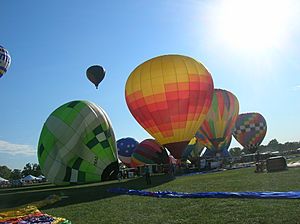
Forest Park gets over 12 million visitors every year! That's more than the number of visitors to Busch Stadium and the Gateway Arch National Park combined. In 2022, USA Today named Forest Park the best city park in the nation.
Many different people visit the park. This includes tourists, local families, and people going to special events. About two-thirds of visitors live within 30 miles of the park. Most people (88%) drive to the park. The rest use public transport, walk, or bike.
The park has many entrances. The Hampton Avenue entrance is very popular. This sometimes causes traffic jams. To help with this, traffic has been moved away from that entrance. Also, trolley-replica buses now shuttle visitors.
Forest Park hosts many fun events each year. These include the Great Forest Park Balloon Race. This is a big hot air balloon competition. There's also the Shakespeare Festival of St. Louis and the St. Louis Earth Day Festival. Other events include wine, beer, and microbrewery festivals. In winter, the Jewel Box greenhouse has a beautiful poinsettia show.
The park also has athletic events. These include the St. Louis Pace Series and the Midnight Ramble (a nighttime bike ride). There's also the Forest Park Cross Country Festival. Many run-walk fundraisers happen here too.
On Art Hill, the St. Louis Symphony Orchestra gives a free outdoor concert in early September. The St. Louis Art Museum also shows free outdoor movies in the summer. Fair St. Louis was held here for the first time in 2014. This was because of renovations at the Gateway Arch.
Amazing Features of Forest Park
Forest Park is home to five of the biggest attractions in the region. These are the Saint Louis Art Museum, the Saint Louis Zoo, the Saint Louis Science Center, the Missouri History Museum, and The Muny theater.
The park also has many places for sports and fun. There's the Dwight Davis Tennis Center and the Steinberg Skating Rink. You can rent boats at the Boathouse Restaurant. There are also golf courses, handball courts, and fields for many sports. The park has over 30 miles of paths for walking and biking.
Saint Louis Zoo
The Saint Louis Zoo is the most visited spot in the park. It's a free zoo that opened in 1910. In 2010, almost 3 million people visited! It has over 18,000 animals.
The zoo has five main areas. The River's Edge has elephants and cheetahs. The Wild has penguins, bears, and apes. The Discovery Zone has a petting zoo. Red Rocks has lions, tigers, and other big cats. Historic Hill is the oldest part. It has the 1904 Flight Cage, a reptile house, and a primate house. There's also Lakeside Crossing with places to eat and shop. The zoo also has a hospital for animals and a nutrition center.
Saint Louis Science Center
The Saint Louis Science Center is on the southern edge of Forest Park. It had over a million visitors in 2010. Part of the science center, the McDonnell Planetarium, is inside the park. A covered bridge connects it to the main building.
The planetarium has an 80-foot (24 m) ceiling. It shows over 9,000 stars! You can also learn about living in space. The center hosts monthly stargazing events too.
Missouri History Museum
The Missouri History Museum is on the northern edge of the park. Over 500,000 people visited in 2010. It has both permanent and changing exhibits.
Two main exhibits are Seeking St. Louis, about the history of Greater St. Louis. The other is 1904 World's Fair, Looking Back at Looking Forward. This exhibit shows items from the World's Fair. The museum has a 16-ton statue of Thomas Jefferson. It was made by Karl Bitter. The museum added a big new part in 2000. This added more exhibit space, a theater, and places to eat and shop.
Saint Louis Art Museum
The Saint Louis Art Museum was originally the Palace of Fine Arts. It was built for the 1904 World's Fair. It's the only permanent building from the fair. The building was designed by Cass Gilbert.
The museum has a huge art collection. It's especially known for Oceanic art, Pre-Columbian art, ancient Chinese bronzes, and 20th-century German art. In 2010, the museum started a big renovation. This project added new gallery space. It also moved parking underground. New landscaping and trees were added. An artist named Andy Goldsworthy created a special sculpture called Stone Sea in 2012.
The Muny
The Muny is an outdoor theater. It has been in Forest Park since 1916. The first show was As You Like It by William Shakespeare. The theater building was built in 1917. Since 1919, The Muny has offered over 1,500 free seats at every show. The amphitheater has 11,000 seats in total.
The Jewel Box
The Jewel Box is a beautiful art deco greenhouse. It's used for events and showing plants. The building has almost 7,500 square feet (700 m2) of display space. It is 55 feet (17 m) high. It was built in 1936 using money from the Works Progress Administration. The Jewel Box was added to the National Register of Historic Places in 2000.
In 2002, the Jewel Box had a $3.5 million renovation. This included new plants and better heating and cooling. It also made the building better for catered events.
Turtle Park
Turtle Park is a fun sculpture park. It was created by Bob Cassilly. You can find it at Oakland Avenue and Tamm Avenue. The park has concrete sculptures of seven types of turtles. These turtles are native to Missouri. There are also sculptures of a clutch of eggs and a snake.
The three big turtles are a snapping turtle, a Mississippi map turtle, and a red-eared slider. The four smaller ones are a stinkpot turtle and three box turtles. The snapping turtle is 40 feet long! It was made with 120,000 pounds of concrete. Kids can climb on the turtles' shells and even in their open mouths.
Dwight Davis Tennis Center
The Dwight Davis Tennis Center is a tennis facility. It has 19 lighted tennis courts and a clubhouse. It's named after St. Louis tennis player Dwight F. Davis. The center offers tennis lessons and hosts tournaments. It's home to the St. Louis Aces, a local tennis team. They play in the 1,100-seat Stadium Court. The courts were updated in 2006 and 2007. New shade awnings and benches were added too.
Boathouse
The Boathouse at Forest Park is a restaurant and a place to rent boats. People have been boating in Forest Park since it opened in 1876. In 1894, a newspaper paid workers to make one of the lakes bigger.
In the early 2000s, a new boathouse opened. You can access both Post-Dispatch Lake and the Grand Basin from here. The boathouse is open all year. You can rent paddle boats there. It was designed by Laurent Torno. It looks like boathouses from the early 1900s.
Pagoda Circle
Pagoda Circle is a circular drive in front of The Muny. It goes around a lake with an island. On the island is the Nathan Frank Bandstand. It was built in 1926 with money from local businessman Nathan Frank. The bandstand is in the classical style. It replaced an older building with Asian designs. In the early 2000s, the area was replanted. Over 27,000 flowers were planted there.
Dennis and Judith Jones Visitor and Education Center
The Dennis and Judith Jones Visitor and Education Center was once called the Lindell Pavilion. It was built in 1892 as a streetcar station. It was designed by Eames and Young in the Spanish Revival style. In 1904, it was used by people visiting the World's Fair. In 1914, it became a golf shop and locker room. It stayed that way until the early 2000s.
After the nearby golf course was renovated, the building became the park's Visitor Center. This $4 million project fixed the clock tower. It also added new heating, air conditioning, restrooms, and locker rooms. Part of the 22,000-square-foot (2,000 m2) building is an event space called the Trolley Room. It can hold up to 400 guests. Forest Park Forever, a local non-profit group, has its office here. Other groups like the Missouri Department of Conservation are also in the building. The restoration also added the Forest Perk Cafe, a coffee and sandwich shop. You can rent cruiser bicycles here from World's Fair Bike Rental.
Steinberg Skating Rink
The Steinberg Skating Rink opened in November 1957. It was built with a donation from the Steinberg Charitable Trust. Etta Steinberg gave over $600,000 for the rink. The rink is open for ice skating in winter. In summer, it's used for sand volleyball.
While ice hockey was played there in the 1950s and 60s, it's too big for regular games now. However, a charity pond hockey tournament is held there at the end of winter. The Snowflake Cafe offers food and drinks.
In the early 2000s, the rink had a $1.4 million renovation. This included a new rink surface and ice-making system. New lights and sound were added. The parking lot was moved from the north to the south side. A new prairie and wetlands area replaced the old north parking lot. This area has a walking path and is great for birdwatching.
The World's Fair Pavilion
The World's Fair Pavilion is on Government Hill. It's where the Missouri Government building for the 1904 World's Fair was. That building burned down just weeks before the fair closed. The pavilion opened in 1910. It was a gift from the World's Fair committee. It helped them keep their promise to restore the park. Designed by English architect Henry Wright, it cost $35,000 to build.
In the early 2000s, the building had a $1.1 million restoration. New restrooms and a catering kitchen were added. The eastern archways were opened up again. New lighting was installed. The two towers were rebuilt.
Forest Park Golf Course
The Forest Park Golf Course opened in 1912 with nine holes. It's also called the Courses at Forest Park or the Norman Probstein Community Golf Course. The first course was designed by Scotsman Robert Foulis. Two more sets of nine holes were added in 1913 and 1915. In 1929, the Forest Park Golf Course hosted a big golf championship.
Between 2001 and 2004, all three courses and the clubhouse were rebuilt. This was led by course designer Stan Gentry. The project was funded by donations from many groups. The three rebuilt courses are named after trees: Hawthorn, Dogwood, and Redbud. Hawthorn is flat and easy to walk. Dogwood is a bit hilly with water. Redbud is very hilly and the hardest. One clubhouse serves all three courses. It has a restaurant called Ruthie's Grill. After the renovations, the Riverfront Times newspaper called it the Best Golf Course in St. Louis.
Highlands Golf and Tennis Center
The Highlands Golf and Tennis Center used to be called Triple A Golf and Tennis Club. It opened in 1897. In 1902, it moved to a 70-acre (280,000 m2) spot near the southeast corner of Forest Park. This was because of the 1904 World's Fair construction. The new facility had a nine-hole golf course, tennis, handball, and volleyball courts. It also had a running track and fields for baseball and lacrosse.
Famous tennis player Jimmy Connors started his career at the Highlands. The facility hosted Davis Cup matches in 1927, 1946, and 1961. Golfer Judy Rankin also started her career here as a young girl. Between 2008 and 2010, the Highlands was completely rebuilt. It now has a new nine-hole golf course, clay tennis courts, and a 30-stall lit driving range. There's also a full-service bar and restaurant called Keagan's Pub and Patio.
Lakes and Water Features
The Cascades are a 75-foot (23 m) waterfall. They are northwest of the Art Museum. They are named after the waterfalls that flowed down Art Hill during the 1904 World's Fair. The park also has Round Lake and Jefferson Lake. Jefferson Lake is stocked with fish for people who like to fish. The Missouri Department of Conservation helps with six fish hatchery lakes in the park. In the early 2000s, the lakes were drained, made deeper, and restocked with fish. A new bridge was also built over the river that feeds the lakes.
Kennedy Forest and Kennedy Woods
Kennedy Forest is in the southwest corner of the park. The Kennedy Woods area is near The Muny in the center. Kennedy Forest has hiking trails that are kept up by the Missouri Department of Conservation. Kennedy Woods has a walking path through wildflowers and native Missouri plants.
Cabanne House
The Cabanne House, built in 1876, is one of the oldest buildings in the park. It's listed on the National Register of Historic Places. The first Cabanne House was built in 1819 by Jean Pierre Cabanné. He was a French Creole fur trader and merchant. His family used it as a farmhouse until they sold the land to the city in 1875. When the park opened, the farmhouse became a lodge. It was torn down in the 1880s.
The current Cabanne House was designed by James H. McNamara in 1875. It was built in the Second Empire style to be the park keeper's house. From 1942, it was the home of the St. Louis Parks and Recreation Commissioner.
The City Beautification Commission fixed the building in 1967. They used it for offices. In the 1980s, the St. Louis Ambassadors, a local group, renovated the building. They now use it as an office and for events. In 1985, the building was added to the National Register of Historic Places because of its architecture.
Statues and Memorials
Near the Cascades waterfall is a statue of Edward Bates from 1876. He was a US Attorney General under President Abraham Lincoln. He was a well-known lawyer and judge in St. Louis. He also helped enslaved people in freedom suits. This was the first statue in the park.
The second oldest statue is of Frank Blair. He was a U.S. Army general and a U.S. senator from Missouri. The statue is at Kingshighway and Lindell boulevards. It was given to the park in May 1885.
At a corner is the Jewish Tercentenary Monument. It was sculpted by Kurt Perisee in 1956. It celebrates 300 years since the first Jewish settlement in New Amsterdam. The main figures represent the Four Freedoms. The monument was designed by Carl C. Mose. It has a flagpole with a wave-like limestone base. The base shows Bible quotes related to Franklin D. Roosevelt’s "Four Freedoms." These are freedom from tyranny, of religion, from fear and war, and from want. A ship, symbolizing the one that brought refugees to New Amsterdam, is also shown. In 1989, the monument was restored.
The Apotheosis of St. Louis is at the north entrance of the St. Louis Art Museum. It's a bronze sculpture of King Louis IX of France on a horse, ready for battle. In the early 2000s, the statue was restored. This included cleaning and adding a protective coating. The original model was shown at the 1904 World's Fair. The finished bronze statue was given to the city in 1906. Two other statues, Sculpture and Painting, are next to the museum entrance.
In 1913, the St. Louis Turnverein gave money for a monument to Friedrich Jahn. He founded the Turnverein and modern gymnastics. The statue was designed by Robert Cauer. It's where the German Pavilion was at the 1904 World's Fair. The next year, in 1914, a Memorial to the Confederate Dead was donated. It was on the north side of the park. It showed an angel and a Southern family sending their son to fight in the American Civil War. This Confederate monument was moved from the park in 2017.
The National Federation of Musicians donated money for the Musicians Memorial and Fountain. It honors Owen Miller and Otto Ostendorf. The memorial was built in 1925 and designed by Victor Holm. Two years later, the Steinberg family donated Joie de Vivre. This sculpture by Jacques Lipchitz shows the joy of life. It's next to the Steinberg Skating Rink.
Near the Jewel Box is the Colonial Daughter Fountain. It was donated in 1947. Also at the Jewel Box is a statue of St. Francis of Assisi. It was sculpted by Carl Mose.
Images for kids
Brickline Greenway
The Brickline Greenway Project is a big partnership. It aims to connect Forest Park and the Washington University in St. Louis campus to the Gateway Arch grounds. Partners include the Arch to Park Collaborative, St. Louis City, and Washington University in St. Louis. Before March 10, 2020, this project was known as the Chouteau Greenway.
See also
 In Spanish: Forest Park (San Luis) para niños
In Spanish: Forest Park (San Luis) para niños
- Culture of St. Louis
- Parks in St. Louis
- St. Louis MetroLink
- Forest Park-DeBaliviere MetroLink station
- Central West End Metrolink Station
- Skinker Metrolink Station
- Bob Cassilly, sculpted statues in the zoo and the large turtle sculptures on the southern side of the park
- Delmar Loop Trolley


